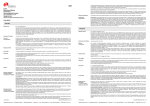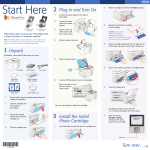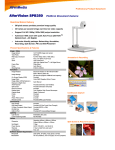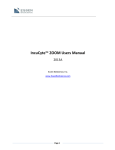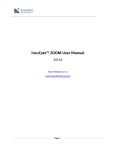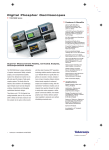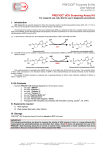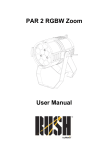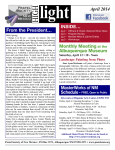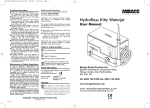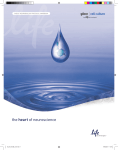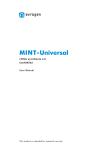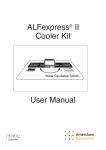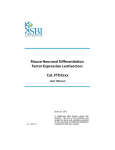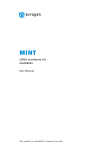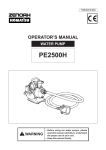Download NeuroPrime™ Cell Kit Product Data Sheet and
Transcript
www.essenbioscience.com Product Information: CellPlayer™ NeuroPrime™ Cell Kit Catalog Number: 4585 Contents 1x vial CellPlayer™ NeuroPrime™ rForebrain Neurons* (2 x 106 cells/vial) 1x vial CellPlayer™ NeuroPrime™ rAstrocytes* (2 x 106 cells/vial) 1x vial CellPlayer™ NeuroLight Red™ Lentivirus -Synapsin promoter (0.45 mL/vial) Lot #: Titer: *Supplied by Molecular Transfer Inc. Storage and Stability Cryopreserved cell vials of NeuroPrime™ rForebrain Neurons and NeuroPrime™ rAstrocytes • Transfer to liquid nitrogen immediately upon arrival. • Cells will remain viable when stored in liquid nitrogen for at least 6 months from the date of receipt. The NeuroLight Red™ Lentivirus • Transfer to -80 °C freezer immediately upon receipt. • Avoid repeated freeze-thaw cycles. • Lentivirus is stable for at least 3 months from date of receipt when stored at -80°C. • Spectral Properties: Ex (max): 588 nm; Em (max): 633 nm Test Size Material supplied is sufficient for 1 x 96-well plate. Product Description The CellPlayer™ NeuroPrime™ Cell Kit contains cryopreserved vials of forebrain neurons and astrocytes isolated from embryonic stage (E18) Sprague-Dawley rats as well as sufficient NeuroLight Red™ lentivirus to perform one 96-well experiment. The lentivirus encodes a red fluorescent protein regulated by a synapsin promoter that selectively drives expression in neurons and minimizes expression in nonneuronal cell types. After six days in co-culture the neurons form extensive neurite networks enabling the neurotoxic or neuroprotective effects of treatments to be assessed. Dynamic changes in network length and branching are measured using IncuCyte ZOOMTM and the NeuroTrackTM software module. USA Essen BioScience, Inc. EUROPE Essen BioScience, Ltd. JAPAN Essen BioScience K.K. 300 West Morgan Road Ann Arbor, MI 48108 USA BioPark, Broadwater Road Welwyn Garden City, Hertfordshire AL7 3AX United Kingdom Cerulean Tower 15F 26-1 Sakuragaoka-cho Shibuya-ku, Tokyo, 150-8512 Japan Phone: +1 734 769 1600 +44 (0) 1707 358688 +81 3 5456 5481 essenbioscience.com www.essenbioscience.com Example Images Following the CellPlayer™ NeuroPrime™ Cell Kit protocol will ensure a neurite network length of at least 50 mm/mm2 after ten days under control conditions using a calibrated Incucyte ZOOM instrument with optimized processing definitions. IncuCyte ZOOM images of the CellPlayer™ NeuroPrime™ Cell Kit after 10 days in culture. Left: Fluorescent image of NeuroLight Red-expressing forebrain neurons in co-culture with astrocytes; Right Phase contrast image of neurons and astrocytes in co-culture. Scale bar: 100µm. CellPlayer™ NeuroPrime™ Cell Kit Protocol Overview Day 0 Plate rNeurons Day 0 (+4 hours) TM Add NeuroLight Red Lentivirus Day 1 Day 3 Day 6, 9, 12, … 95% media Replacement 50% media replacement 50% media replacement Plate rAstrocytes Add Uridine + 5FDUridine Treatments @ day 6 and beyond Begin IncuCyte scanning 2 8000-0280-B00 www.essenbioscience.com Protocol: CellPlayer™ NeuroPrime™ Cell Kit Materials required but not supplied Equipment • • • • • • • • • • • 96-well plate, flat-bottom – Corning (Cat. No. 3595) or TPP (Cat. No. 92096) Class 2 Tissue culture hood Centrifuge for pelleting cells (250 g capability; inserts for 50 mL conical tubes) Multichannel hand-help pipettor (200 µL) P-1000 handheld pipettor Cell counting system (hemocytometer or automated) Sterile 50 mL conical tubes for making cell dilutions Sterile troughs for preparing and containing cells and test compound dilutions Tissue culture incubator (37°C, 5% CO2, humidified atmosphere) IncuCyte ZOOM with CellPlayer™ NeuroTrack™ Software Module (Cat. No. 9600-0010) Water bath set to 37°C Reagents • • • • • • • • • • Poly-D-Lysine – Millipore (Cat. No. A-003-E) WFI water – Corning CellGro Mediatech (Cat. No. 25-055-CM) Neurobasal Media – Life Technologies (Cat. No. 21103049) B-27 Serum Free Supplement – Life Technologies (Cat. No. 17504044) GlutaMAX-I Supplement – Life Technologies (Cat. No. 35050061) DMEM – Life Technologies (Cat. No. 11965 or 41965) Fetal Bovine Serum – Sigma Aldrich (Cat. No. F2442) or Thermo Scientific (Cat. No. SH3007103) 5-Fluoro-2’-deoxyuridine – Sigma Aldrich (Cat. No. F0503) Uridine – Sigma Aldrich (Cat. No. U3003) 70% ethanol w/v Solutions to prepare in advance Day -1 • Poly-D-Lysine – o 100 µg/mL in 12 mL of WFI quality water Day 0 • Neuronal Culture Media – for 50 mL o 48.5 mL Neurobasal Media o 0.5 mL GlutaMAX I o 1 mL B-27 Supplement Day 1 • Neuronal Culture Media – for 50 mL o 48.5 mL Neurobasal Media o 0.5 mL GlutaMAX I o 1 mL B-27 Supplement • Astrocyte Culture Media – for 50 mL o 42.5 mL DMEM o 7.5 mL FBS 3 8000-0280-B00 www.essenbioscience.com Day 3 • 10x FdU/U – o Dissolve 8 mg of FdU and 28 mg of U in 100 mL Neurobasal. o Aliquot and store at -20 °C. • 2x FdU/U o Thaw 10x stock of FdU/U on ice o Dilute to 2x in 12 mL of NCM in 15 mL conical tube Add 2.4 mL 10x FdU/U Add 9.6 mL NCM ! CRITICAL Use rigorous aseptic technique at all times. Only open the culture plate and medium bottles within a in a tissue culture hood. Day -1 Coat 96-well plate with Poly-D-Lysine 1. Coat one 96-well plate with Poly-D-Lysine. Prepare a 1x stock of Poly-D-Lysine (final concentration – 100 μg/mL) in WFI quality water and add 100 µL to each well. Replace lid and Incubate for 16-20 hours at room temperature in the tissue culture hood. 2. Aspirate and discard the Poly-D-Lysine and rinse the plate twice with 150 µL/well of WFI water. If excess Poly-D-Lysine is not washed away it can impair neurite outgrowth. 3. Leave the plate to dry for at least one hour with lid removed in the tissue culture hood. Day 0 Thaw and plate neurons 1. Prepare the Neuronal Culture Media (NCM). For 50 mL of complete Neurobasal culture media, add 1 mL of B-27 Serum-free supplement, 0.5 mL GlutaMAX I to 48.5 mL of Neurobasal media in a 50 mL conical tube. 2. ! CRITICAL Warm NCM to 37 °C prior to thawing neurons. 3. Remove the vial of NeuroPrime™ rForebrain Neurons from liquid nitrogen storage and thaw in a 37°C water bath until only a tiny ice crystal remains (1 to 2 minutes). ! CRITICAL Do not agitate the vial during this step. 4. Wipe outside of vial with 70% ethanol. 5. In tissue culture hood, use a P1000 pipettor to pre-wet a tip with 1 mL NCM. 6. Use the pre-wetted tip to transfer the 1 mL volume of thawed neuronal cells to a 50 mL conical tube. 4 8000-0280-B00 www.essenbioscience.com 7. Rinse the cryo-vial with 1 mL NCM and transfer the rinse media in a drop-wise fashion to the 50 mL conical tube containing neurons, while gently swirling the 50mL conical tube. ! CRITICAL Rapid addition of the media at this point can result in osmotic shock and cell death. The 1mL addition should take about 30 seconds. 8. In drop-wise fashion, add a further 2 mL pre-warmed NCM to the 50 mL conical tube. The 2 mL addition should take about 1 minute. 9. Perform a cell count (e.g. Trypan Blue staining with hemocytometer) and dilute neurons to 150,000 cells/mL in pre-warmed NCM. The cell suspension can be transferred to a sterile trough in the tissue culture hood at this point in order to facilitate pipetting of cells in the next step. 10. Using a multichannel handheld pipette, dispense 100 μL of neuronal cell suspension into each well of the Poly-D-Lysine coated 96-well plate (15,000 neurons/well). ! CRITICAL To ensure proper mixing and uniform seeding of the neurons, mix the cell suspension by gently pipetting up and down 1-2 times between seeding each row of the plate. Rocking the trough is also recommended to ensure equal cell distribution. 11. Let the plate stand at room temperature in the tissue culture hood for 30 minutes and then place inside the incubator. ! CRITICAL This step ensures the uniform distribution of cells in each well. 12. Allow cells to settle on the plate for 2 to 3 hours before proceeding. Infect neurons with NeuroLight Red Lentivirus 1. Allow the NeuroLight Red Lentivirus to thaw on ice (approximately 1 hour). 2. ! CRITICAL Use the equation below to calculate the volume of lentivirus required to achieve an MOI of 1 when diluted into 11 mL of NCM, based on the viral titer supplied on the vial label (e.g. for a viral titer of 5 x 106 TU/mL add 0.33 mL (330 µL) lentivirus to 11 mL of Neuronal culture media). = 11Neuronalculturemedia . ∗ /011 % + ∗ 0.1 $ 15,000)* 3. Based on the results of the calculation above, dilute the appropriate amount of NeuroLight Red reagent into 11ml NCM so that an MOI of 1 is achieved when 100 µL is added to each well of the plate. Mix the virus and media by pipetting up and down. 4. At 2-4 hours post plating, remove plated neurons from incubator. 5. Using a multichannel pipettor, add 100 µL virus solution per well (at MOI = 1), without mixing, and return to incubator immediately. ! CRITICAL Do not pipette up and down after adding the virus solution as this may result in damage to the plated neurons. 5 8000-0280-B00 www.essenbioscience.com Day 1 Plate astrocytes 1. 16-24 hours after plating and infecting the neurons, warm NCM to 37°C. 2. Carefully remove 190 µL of medium per well using a multi-channel pipettor, and replace immediately with 140 µL of fresh, pre-warmed NCM. Volume should now be 150 µL per well. 3. Prepare 50 mL Astrocyte Culture Media (85% DMEM + 15% FBS; ACM) by adding 7.5 mL FBS to 42.5 mL DMEM and warm to 37°C. 4. Remove the vial of NeuroPrime™ rAstrocytes from liquid nitrogen storage and thaw in a 37°C water bath until only a tiny ice crystal remains (1 to 2 minutes). 5. Wipe vial with 70% ethanol. 6. In tissue culture hood, use a P1000 pipettor to pre-wet a tip with 1 mL ACM. 7. Use the pre-wetted tip to transfer the 1 mL volume of thawed astrocytes to a 50 mL conical tube. 8. Rinse the cryo- vial with 1 mL ACM. ! CRITICAL Rapid addition of the media to the cell suspension at this point can result in osmotic shock and cell death. Transfer the rinse media in a drop-wise fashion to the 50 mL conical tube containing astrocytes, while gently swirling the 50mL conical tube. 9. Add 3 mL pre-warmed ACM to the 50 mL conical tube in a drop-wise fashion. The 3mL addition should be performed slowly, taking at least 1 minute. 10. Centrifuge the astrocytes at 250 x g for 5 min. Carefully aspirate and discard the supernatant and resuspend the cell pellet in 5 mL of ACM. Using a P-1000 handheld pipet set to 800 µL, triturate the cell suspension by gently aspirating and dispensing 10-15 times to ensure a single cell suspension. 11. Perform a cell count (e.g. Trypan Blue staining with hemocytometer) and dilute cells to 300,000 cells/mL in pre-warmed ACM. 12. Using a multichannel handheld pipettor, plate 50 µL of astrocyte cell suspension into each well of the 96-well plate containing the cultured neurons (i.e. 15,000 astrocytes/well). ! CRITICAL To ensure proper mixing and uniform seeding of the astrocytes, mix the cell suspension by gently pipetting up and down 1-2 times between seeding each row of the plate. Rocking the trough is also recommended to ensure equal cell distribution 13. Place plate into the IncuCyte ZOOM and schedule to image every 2 to 12 hours. (See IncuCyte ZOOM User Manual for detailed instructions on setting up an imaging schedule.) Day 3 Treat plate with 5-Fluoro-2’-deoxyuridine and Uridine ! CRITICAL Addition of 5-Fluoro-2’-deoxyuridine and Uridine (FdU/U) prevents proliferation of nonneuronal cell types. 6 8000-0280-B00 www.essenbioscience.com 1. Remove 100 µL of media from each well using a multi-channel pipette and replace with 100 µL fresh Neuronal Culture Media containing 2x concentrations of 5-Fluoro-2’-deoxyuridine and uridine to a final assay concentration of 8 μg/mL and 28 μg/mL, respectively. Days 6, 9, 12 and beyond Solutions Required 1. Neuronal Culture Media – for 50 mL a. 48.5 mL Neurobasal Media b. 0.5 mL GlutaMAX I c. 1 mL B-27 Supplement Feeding Cultures 1. Feed cultures with fresh NCM by performing a 50% media change. To do this, remove 100 µL per well and replace with 100 µL of fresh media. ! CRITICAL Only a single FdU/U treatment is required (Day 3, step 1). Addition of fresh FdU/U is not recommended on following days. 2. Cultures can be stopped at Day 11 or continued for desired length, with 50% media changes occurring every third day. Example Data Use of the CellPlayer™ NeuroPrime™ Cell Kit according to the protocols described above will enable a robust and reliable assay for neurite outgrowth. The figure below shows data obtained from a single 96 well plate assay over 12 days, where with all wells were fed with NCM. Day 3 2 Neurite Length (µM/mm ) 200 150 100 50 0 50 100 Day 6 150 Time (hr) 200 250 Day 9 7 Day 12 8000-0280-B00 www.essenbioscience.com Neurite length measurements and IncuCyte ZOOM images obtained using NeuroLight Red-infected NeuroPrime rForebrain Neurons in co-culture with NeuroPrime rAstrocytes. Upper left panel plots mean neurite length (+ SD) over time for all wells from a 96 well plate. Images from a single well at 3, 6, 9 and 12 days after plating as indicated. Scale Bar: 200µM. Safety Considerations The backbone of the Lentivirus particles in this system has been modified to improve their safety and minimize their relation to the wild-type, human HIV-1 virus. These modifications include: • • • The lentiviral particles are replication-incompetent and only carry the non-oncogenic gene of interest. A deletion in the 3’ LTR (ΔU3) resulting in “self-inactivation” (SIN) of the Lentivirus after transduction and genomic integration of the target cell (Yee et al., 1987; Yu et al., 1986; Zufferey et al., 1998). This alteration renders the lentiviral genome incapable of producing package able virus following host integration. The envelope is psueudotyped with the VSV-G gene from Vesicular Stomatitis Virus of the HIV-1 envelope (Burns et al., 1993; Emi et al., 1991; Yee et al., 1994). Replication-defective lentiviral vectors, such as the 3rd generation vector provided in this product, are not known to cause any diseases in humans or animals. However, lentivirus particles still pose some biohazardous risk because they can transduce primary human cells and can integrate into the host cell genome thus posing some risk of insertional mutagenesis. For this reason, we highly recommend that you treat lentiviral stocks as Biosafety Level 2 (BSL-2, BL-2) organisms and strictly follow all published BL-2 guidelines with proper waste decontamination. For more information about the BL-2 guidelines and Lentivirus handling, we recommend referring to local documentation based on geography. The Essen BioScience 3rd generation HIV-based lentivirus’ meet BL2 requirements based on the criteria in the document, “Biosafety in Microbiological and Biomedical Laboratories”, 5th Edition, published by the Centers for Disease Control (CDC). This document may be downloaded at http://www.cdc.gov/biosafety/publications/bmbl5/index.htm. Institutional Guidelines: Safety requirements for use and handling of lentiviruses may vary at individual institutions. We recommend consulting your institution’s health and safety guidelines and/or officers prior to implementing the use of these reagents in your experiments. A detailed discussion of lentiviral vectors is provided in Pauwels, K. et al (2009). State-of-the-art lentiviral vectors for research use: Risk assessment and biosafety recommendations. Curr. Gene Ther. 9: 459-474. Biohazard Note The NeuroPrime™ rForebrain Neurons and rAstrocytes contain cells of rodent origin. Although the cells test negative for mycoplasma, bacteria and fungi, no test procedure can guarantee the absence of known and unknown infectious agents. Consequently, all products should always be considered potentially biohazardous and appropriate precautions should be taken. Use good laboratory practice and aseptic technique at all times. 8 8000-0280-B00 www.essenbioscience.com Licenses and Warranty Essen BioScience warrants that this product performs as described on the product label and in all literature associated with the sale of said product when used in accordance with the described protocol. This limited warranty is the sole warranty. No other warranties exist that extend beyond this warranty, either expressed or implied. Essen BioScience disclaims any implied warranty of merchantability or warranty of fitness for a particular purpose. Essen BioScience disclaims any responsibility for injury or damage and shall not be liable for any proximate, incidental or consequential damages in connection with this product. If it is proven to the satisfaction of Essen BioScience that this product fails to meet performance specifications, Essen BioScience’s sole obligation, at the option of Essen BioScience, is to replace the product or provide the purchaser with credit at or below the original purchase price. This limited warranty does not extend to anyone other than the purchaser. Notice of suboptimal performance must be made to Essen BioScience within 30 days of receipt of the product. This Essen BioScience product contains proprietary nucleic acid(s) coding for proprietary fluorescent protein(s) being, including its derivatives or modifications, the subject of pending patent applications and/or patents owned by Evrogen JSC (hereinafter “Evrogen Fluorescent Proteins”). The purchase of Essen BioScience products incorporating these fluorescent proteins conveys to the buyer the non-transferable right to use Evrogen Fluorescent Proteins only for research conducted by the buyer. No rights are conveyed to modify or clone the gene encoding fluorescent protein contained in this product or to use Evrogen Fluorescent Proteins for commercial purposes. The right to use Evrogen Fluorescent Proteins specifically excludes the right to validate or screen compounds for commercial purposes. For information on commercial licensing, contact Evrogen Licensing Department, email: [email protected]. For research use only. Not for therapeutic or diagnostic use. 9 8000-0280-B00









